Bls recertification - Study guides, Class notes & Summaries
Looking for the best study guides, study notes and summaries about Bls recertification? On this page you'll find 69 study documents about Bls recertification.
All 69 results
Sort by
BLS Recertification course exam Questions and Answers with Complete Solutions | Updated 2024
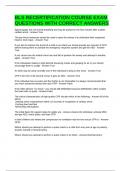
-
BLS RECERTIFICATION COURSE EXAM QUESTIONS WITH CORRECT ANSWERS
- Exam (elaborations) • 2 pages • 2024
- Available in package deal
-
- $10.49
- + learn more
BLS RECERTIFICATION COURSE EXAM QUESTIONS WITH CORRECT ANSWERS
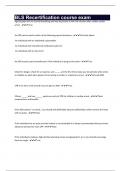
-
BLS Recertification course exam
- Exam (elaborations) • 3 pages • 2024
-
- $7.99
- + learn more
Agonal gasps are not normal breathing and may be present in the first minutes after sudden cardiac arrest - True An AED can be used in which of the following special situations - All of the above An individual with an implanted a pacemaker An individual with transdermal medication patch on An individual with a hairy chest An AED may be used normally even if the individual is lying on the snow - True Check for danger, check for a response, and _____ are the first three steps you should tak...

-
BLS Recertification
- Exam (elaborations) • 5 pages • 2024
-
- $10.49
- + learn more
At what rate should compressions be administered? - 100-120 per minute BLS - the care healthcare providers and public safety professionals provide to patients who are experiencing respiratory arrest, cardiac arrest, or airway obstruction Distinguish between respiratory arrest and cardiac arrest - Respiratory-no breathing but has pulse Cardiac-no breathing and no pulse How deep should compressions be? - Adult-at least 2 inches Child-around 2 inches Infant-around 1.5 inches How do you car...
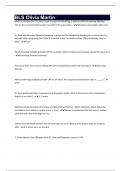
-
BLS Recertification course exam 100% Passed
- Exam (elaborations) • 2 pages • 2024
-
- $2.99
- + learn more
Olivia is unresponsive. Dr. Dave needs to assess for breathing, a pulse and life-threatening bleeding. Choose the recommended location to perform the pulse check. - Brachial artery (upper right arm) Dr. Dave should assess Olivia for breathing, a pulse and life-threatening bleeding for no more than 10 seconds. After recognizing that Olivia is in cardiac arrest, he should initiate CPR immediately, true or false? - True When providing multiple-provider CPR for an infant, which compression tech...
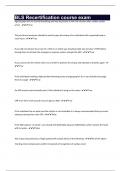
-
BLS Recertification course exam
- Exam (elaborations) • 3 pages • 2024
-
- $7.99
- + learn more
Agonal gasps are not normal breathing and may be present in the first minutes after sudden cardiac arrest - True The jaw thrust maneuver should be used to open the airway of an individual with suspected head or neck injury - True If you did not witness the arrest of a child or an infant you should provide two minutes of CPR before leaving them to activate the emergency response system and get the AED - True If you cannot see the infants chest rise and fall re-position the airway and attemp...
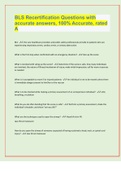
-
BLS Recertification Questions with accurate answers, 100% Accurate, rated A
- Exam (elaborations) • 4 pages • 2023
-
Available in package deal
-
- $8.49
- + learn more
BLS Recertification Questions with accurate answers, 100% Accurate, rated A BLS - -the care healthcare providers and public safety professionals provide to patients who are experiencing respiratory arrest, cardiac arrest, or airway obstruction What is the first step when confronted with an emergency situation? - -Size up the scene What is involved with sizing up the scene? - -Determine if the scene is safe, how many individuals are involved, the nature of illness/mechanism of injury; ...
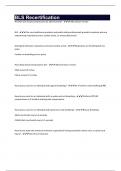
-
BLS Recertification
- Exam (elaborations) • 5 pages • 2024
- Available in package deal
-
- $7.99
- + learn more
At what rate should compressions be administered? - 100-120 per minute BLS - the care healthcare providers and public safety professionals provide to patients who are experiencing respiratory arrest, cardiac arrest, or airway obstruction Distinguish between respiratory arrest and cardiac arrest - Respiratory-no breathing but has pulse Cardiac-no breathing and no pulse How deep should compressions be? - Adult-at least 2 inches Child-around 2 inches Infant-around 1.5 inches How do you car...
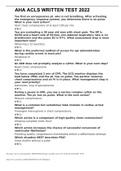
-
AHA ACLS Written Test ( A+ GRADED 100% VERIFIED) LATEST 2022
- Exam (elaborations) • 8 pages • 2022
-
Available in package deal
-
- $9.49
- 1x sold
- + learn more
AHA ACLS Written Test ( A+ GRADED 100% VERIFIED) LATEST 2022 acls test,bls test,acls test question,acls certification,acls review,passed acls by 100 percent,passing acls in 10 minutes,acls bls training,acls/bls training,aha test,asystole acls,how to insert et-tube,acls,test,v-tact acls,how to give breaths in cpr,american heart association,bls certification,nurse practitioner,same day cpr certification,tips for bls certification,atrial fibrillation,tips for acls certification,aha,bls recertifi...

-
BLS Recertification
- Exam (elaborations) • 5 pages • 2024
-
- $10.99
- + learn more
At what rate should compressions be administered? - 100-120 per minute BLS - the care healthcare providers and public safety professionals provide to patients who are experiencing respiratory arrest, cardiac arrest, or airway obstruction Distinguish between respiratory arrest and cardiac arrest - Respiratory-no breathing but has pulse Cardiac-no breathing and no pulse How deep should compressions be? - Adult-at least 2 inches Child-around 2 inches Infant-around 1.5 inches How do you car...

Study stress? For sellers on Stuvia, these are actually golden times. KA-CHING! Earn from your study resources too and start uploading now. Discover all about earning on Stuvia



